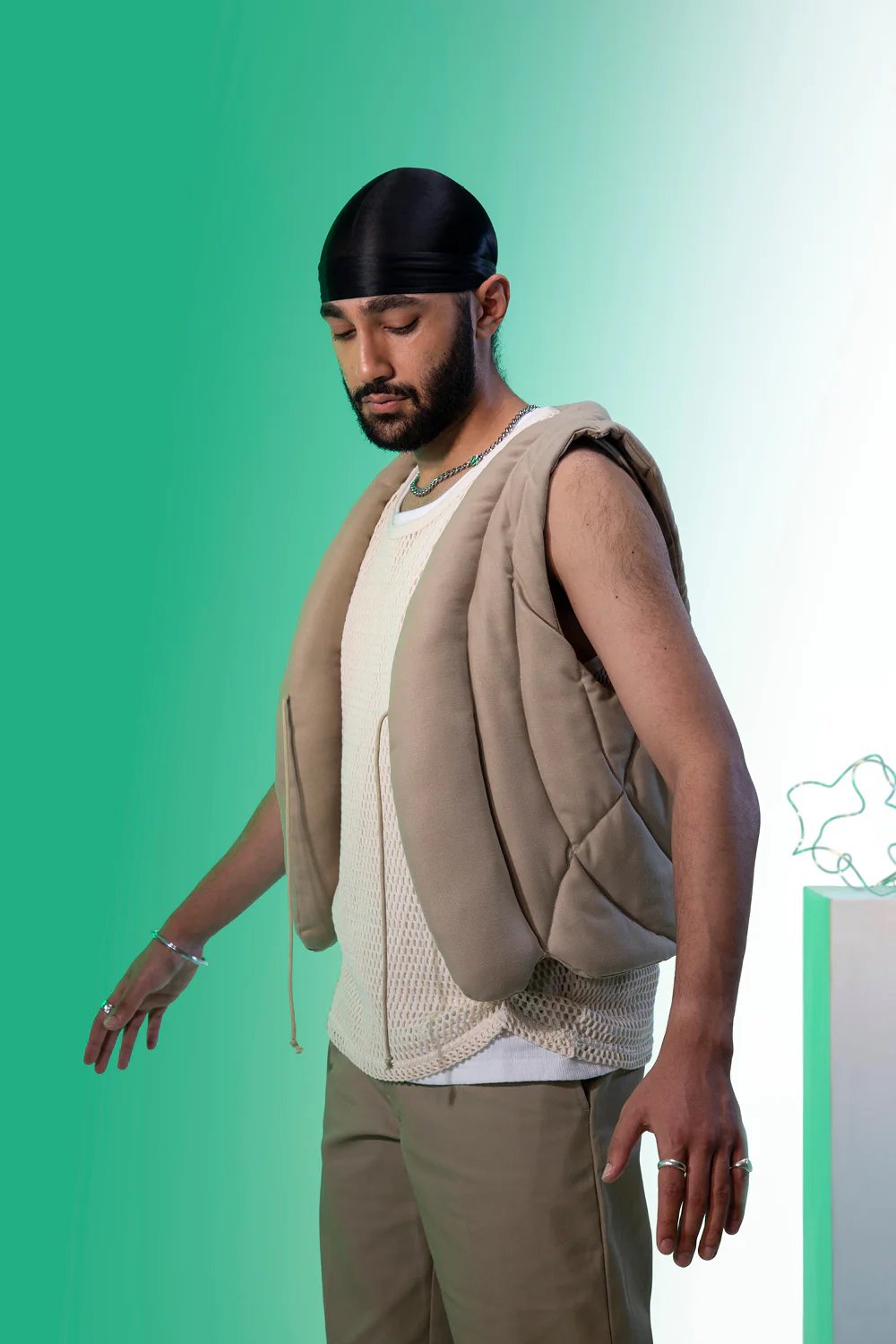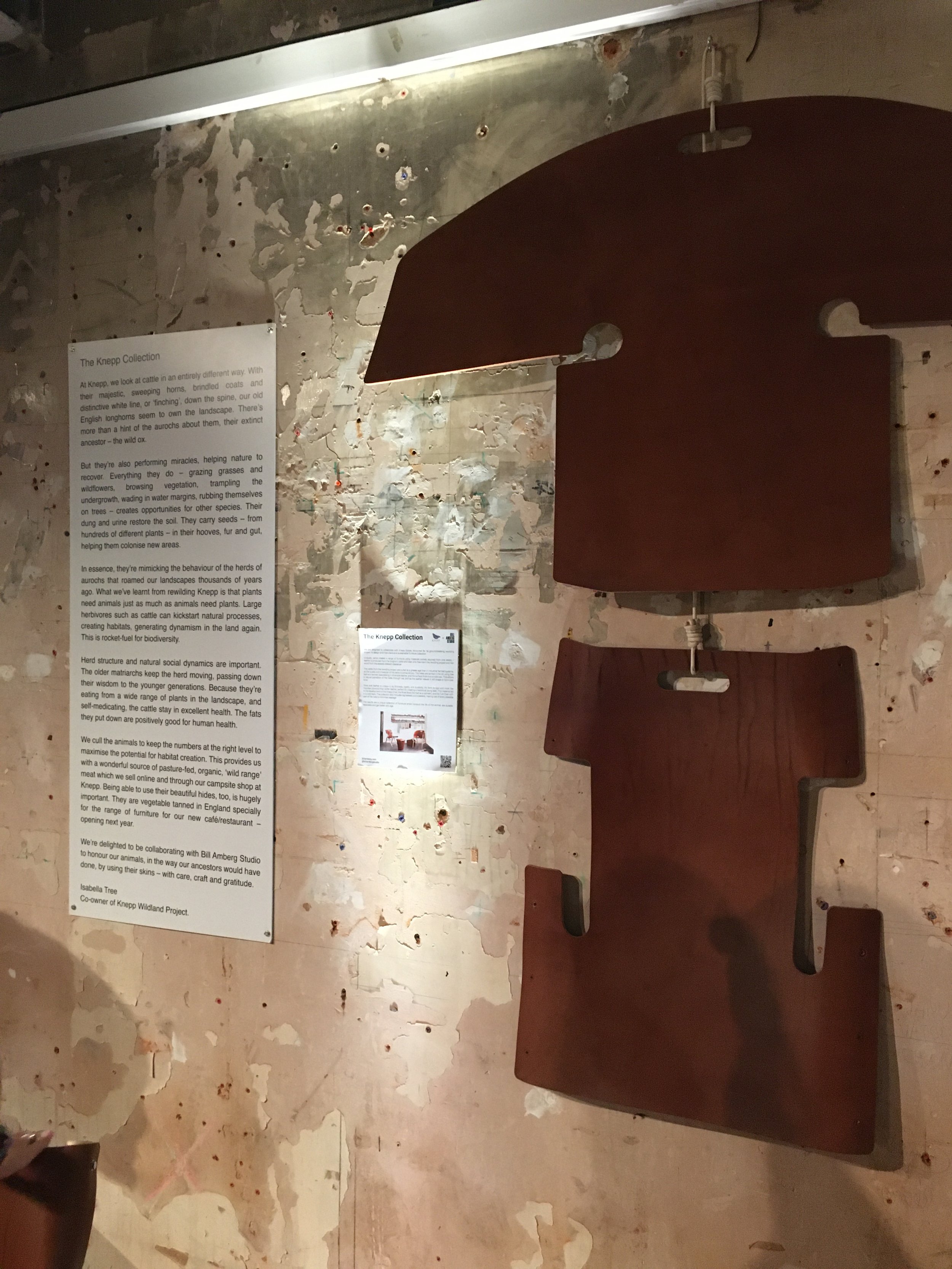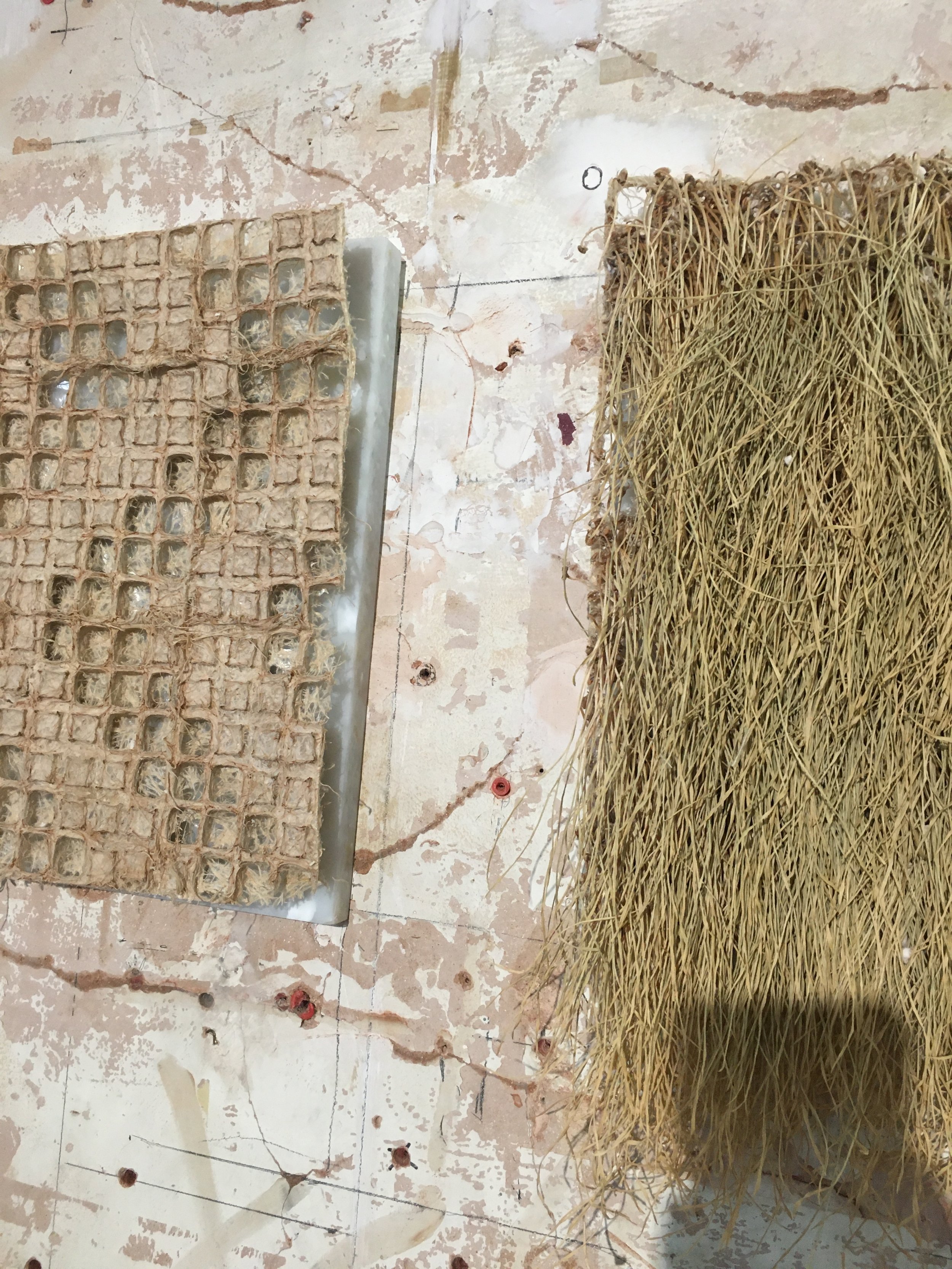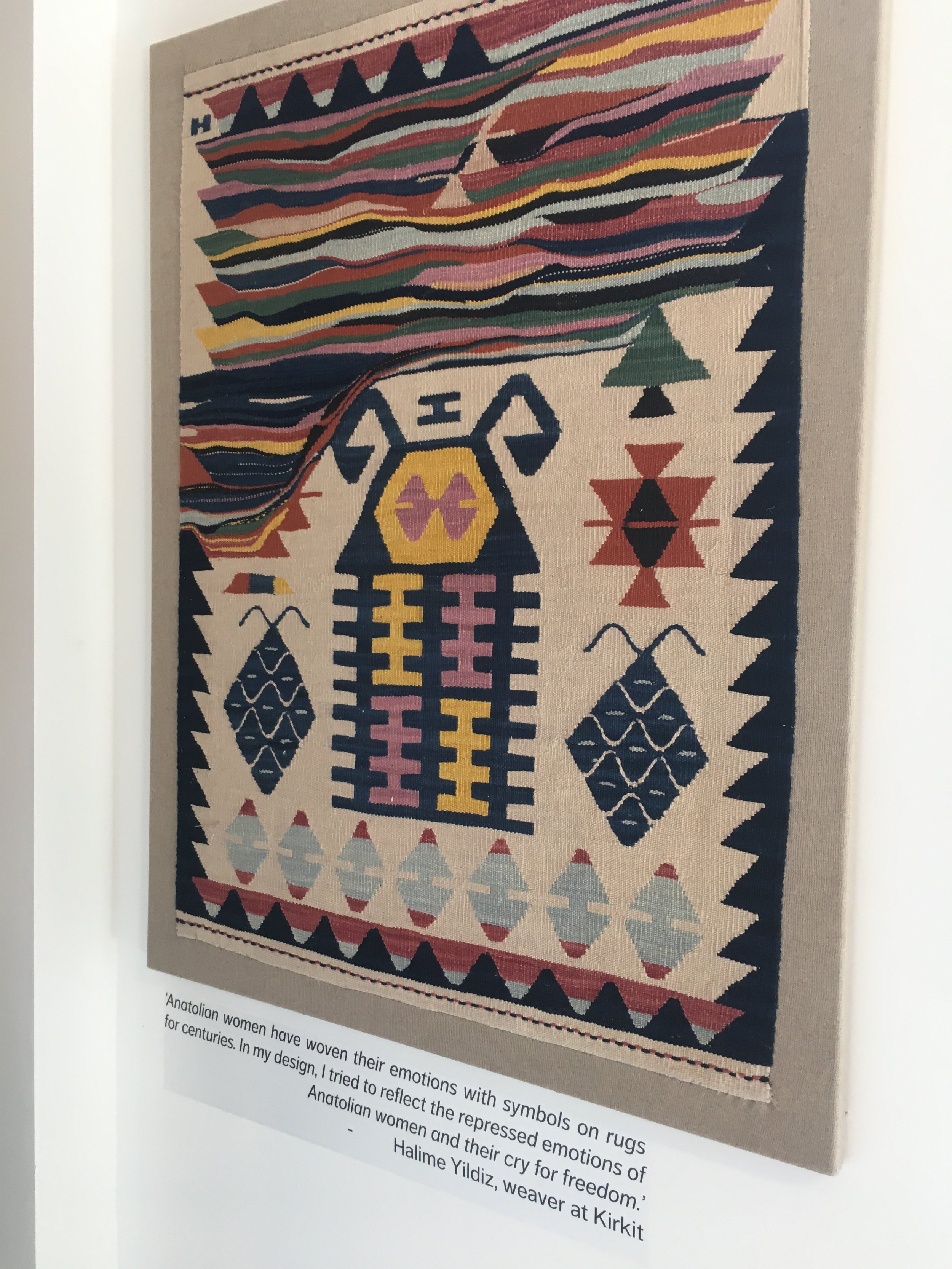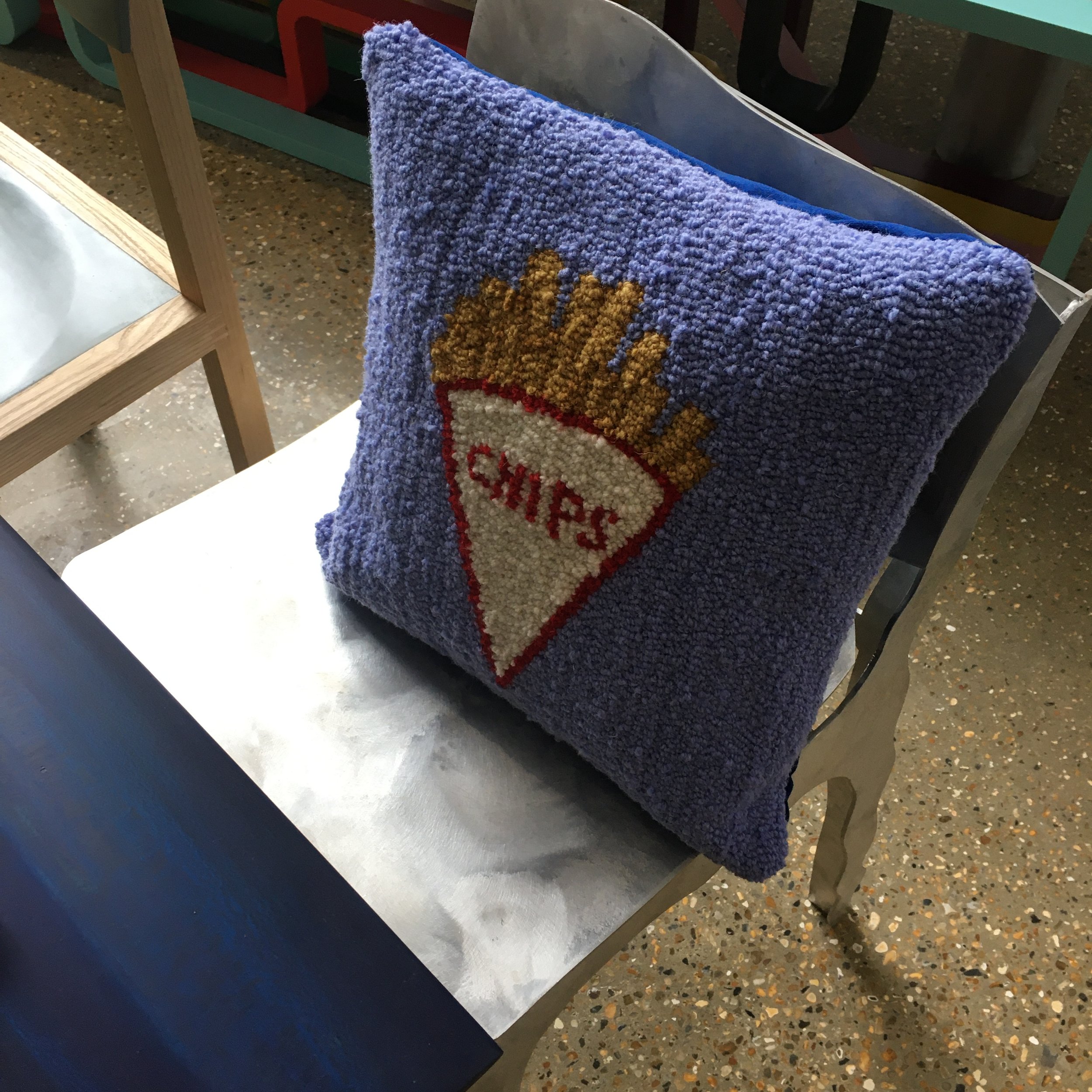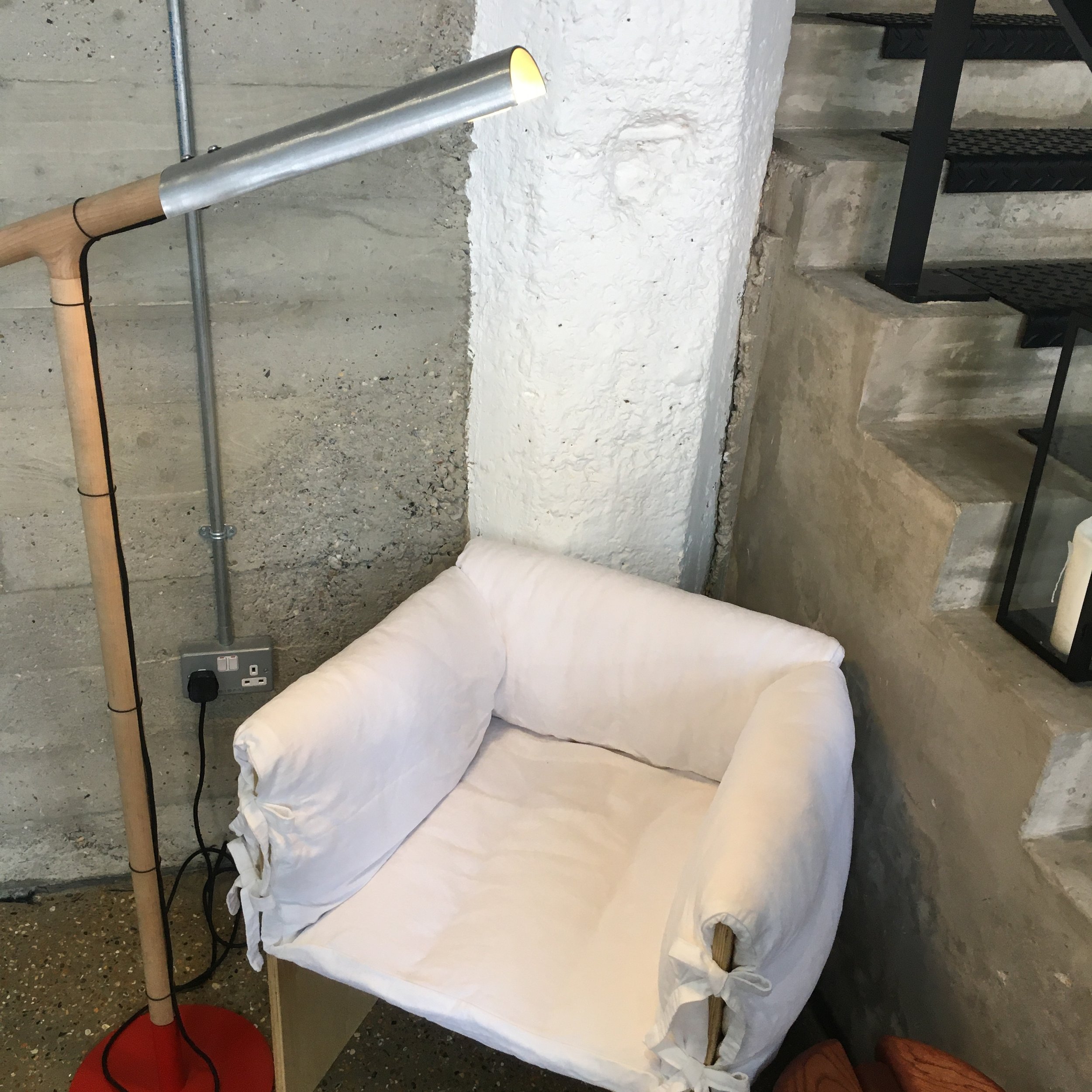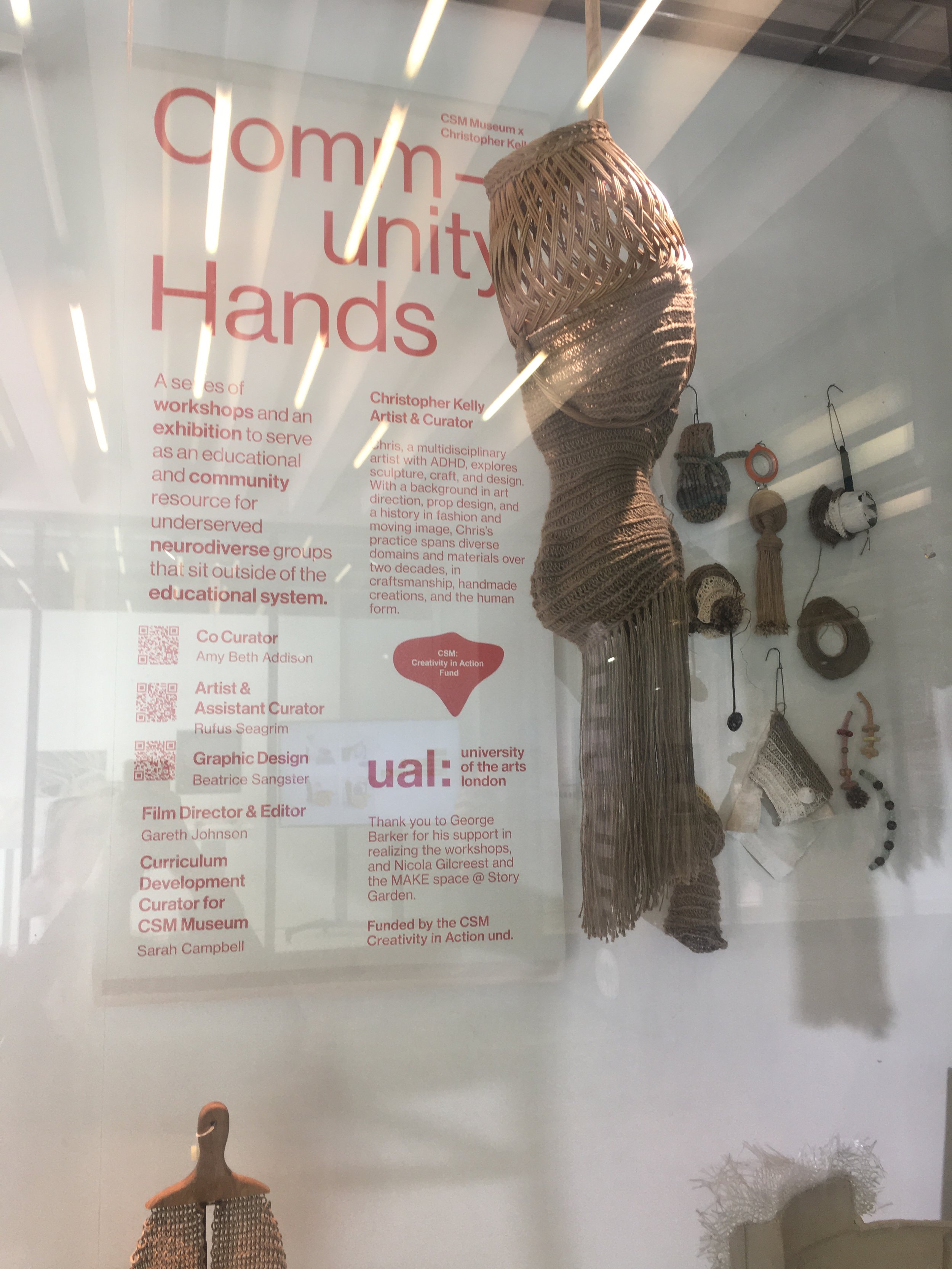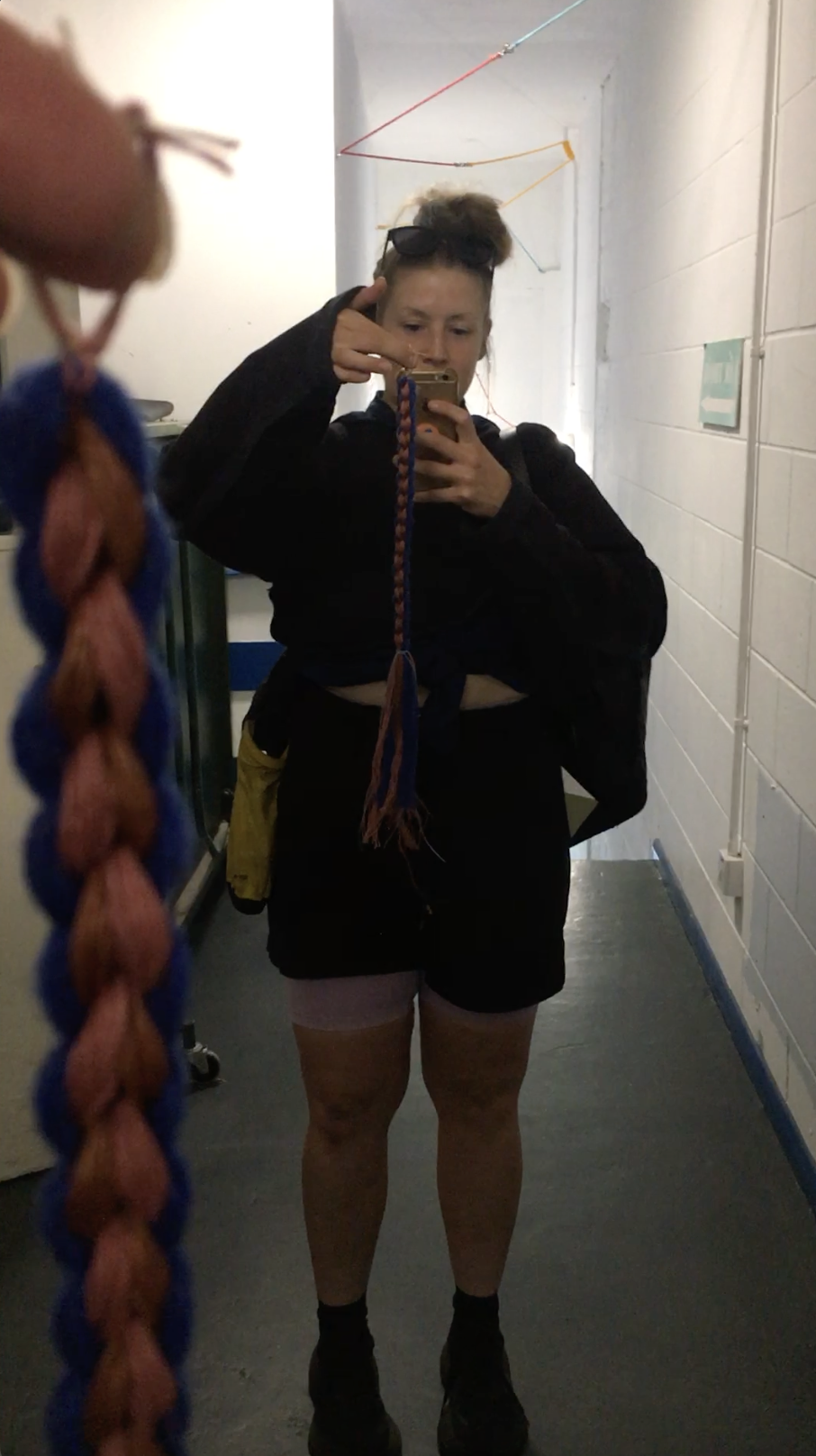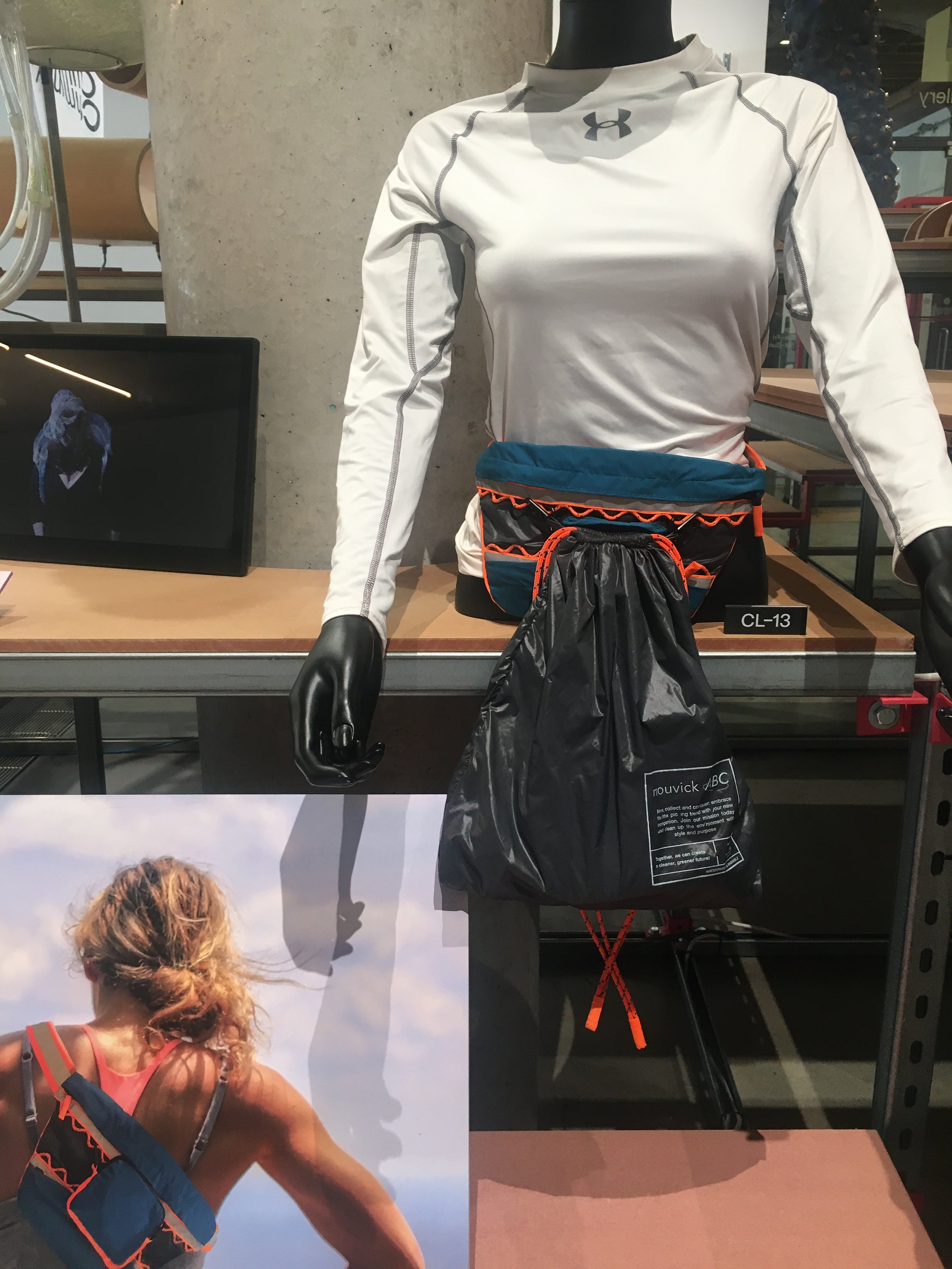Textiles (London Design Festival).
London Design Festival aims to celebrate London as the “design capital of the world”.
Each year, projects are displayed across the city as standalone exhibits or as part of Design Trails across so-called Design Districts that visitors can follow. There are also a couple of Design Fairs showcasing wider categories and hosting panel talks.
It’s fairly draining, frankly. And if you have minimal days to visit, then you really have to choose your spots and plan your route. I had 1.5 days and mostly stayed in the East of the city (London Fields, Hoxton, Shoreditch), the south bank, and did a bit of the North (King’s Cross).
There’s a post that specifically considers the designers/makers at Material Matters, though a handful of projects from there are highlighted here under the “textile” banner. If you’d like to learn specifically about that exhibit, head to the blog post here: Material Matters (London Design Festival).
But — textiles.
This encompasses any material made in some part from a fibre, a skin or a fur that is also malleable in some way. Nowadays, it also includes those materials created in labs from biofabricated sources, such as mycelium networks or seaweed and so can also regard plant/fungi sources even if not typically fibrous.
The textiles on show at London Design Festival ranged from your standard use of woven or knitted fabrics, yet also those materials that are easily manipulated to be worn in some way. In an Infinite Monkey Cage episode ‘Magic Materials’, Anna Ploszajski suggested textiles are anything that a jacket can be made from.
Read on for some highlights of textile products, though I’d particularly like you to take away the solutions that textile production can offer rather than the products themselves. Despite textiles being horrifically polluting and exploitative, this industry (whether industrial or craft-based) can provide such magical stories of wisdom and heritage that support systemic shifts to our current extractive practices — and fortunately the makers on show at the Festival offered these perspectives. The article is split into separate exhibits/design studios.
If you want a taster of the textiles on show before you scroll down, here’s an Instagram reel.
Textiles at London Design Festival 2023.
Christopher Farr’s Studio was one of the spaces visited on this two-day Design Festival research trip.
Surface Matter.
Surface Matter are a Hackney-based studio specialising in helping architects and designers make “better” choices about the materials they use in their projects. Many times I’d walked past but never visited, not realising that they had a materials library of sorts that you could view. They collect samples from all sorts of places and they’re on show (some are now unavailable in real life) so in itself as a studio it’s a nice place to visit — and the staff there were very welcoming and eager to tell you about what they had.
Amongst a lot of hard surface materials made from collected plastic, salvaged metals and stone, and paper waste, there were some intriguing materials under the textile banner. Though they were intended for interior spaces, I could still imagine them used in the fashion industry as accessories.
Pierreplume ⇾ is a lightweight acoustic panel made using discarded textiles. Looking at the panels as they were, you’d think ok they’re interesting with a comforting texture… but it wasn’t until I spoke to the team that I understood the different colours of course regarded the textile source. The grey panels were from an amalgamation of whatever textiles, with the white/cream ones from mattresses and the like, and the navy ones came from Fire Service uniforms. This completely adds to the story and takes you on the way to recognising the strands of textile waste there actually are (like I’d forgotten about mattress manufacturing waste, and of course Fire Service uniforms become defunct at some point!)
Images: Pierreplume lightweight acoustic panels made from various sources of pre- and post-consumer textile “waste” in shades of cream, grey and blue. [Credit: 1. Own; 2. Surface Matter]
Opt Studio ⇾ created these utterly fascinating fur-like 3D printed textiles. It’s simply fascinating that these super malleable, soft and comforting materials were made using a printer. Unfortunately I can’t find them online so perhaps they’re no longer in production.
Rezign® from .Planq ⇾ I realised that these recycled textile veneers were the ones on the main image I used for my Material Matters review when I compained about more chairs being designed. But again it is a cool material that tells a story; though the piece I held at the studio was soft like Pierreplume, they make a veneer using textile waste, such as old denim, army clothing, suits, and air steward uniforms (sometimes blended with flax, hemp, and jute coffee bags). The fibres are first shredded into small pieces and then carded into felt, then pressed with a biodegradable binder made of potato or corn starch into a hard veneer. I almost thought it could be interesting if retail stores used this veneer for their fittings to tell a story, but then it would seem textile discard is ok.
Katalin Huszar ⇾ no longer being produced; this flexible-yet-hard material was made out of discarded/collected single-use plastic straws but since the UK ban came into effect, there is no local source. Which is really only a great thing. I found it a fun material nevertheless, and hadn’t guessed it was straws.
Hannah Williams ⇾ a marbled silicone material — MarbleSil® — that is used in fashion applications amongst others, as it is heatproof, sliproof and waterproof (and utterly vibrantly fun). There’s no information about how it’s created (see the ®) though considering silicone is an oil-based synthetic polymer, it’s not particularly sustainable (unless you’re considering the longevity and durability of it).
Images: 1. OPT Studio 3D printed textile; 2. Rezign® recycled denim felt from .Planq; 3. Marblesil® marbled silicone from Hannah Williams; 4. Heat pressed single-use plastic straws from Katalin Huszar.
Atelier100.
Atelier100 is an H&M and Ingka Group initiative that champions product designers, fashion designers and makers located within 100km of London, all working with local materials and inspired by their London surroundings. Their Drop002 store showcased some of those products, all selected through an open call and sold via their platform.
Amongst jewellery, home products, footwear and furniture, there were of course fashion garments. I appreciated that they considered the fabric’s story and intention. Watch a reel of all the Drop002 designers.
Puffer Vest from Matan Fadida — chunky, comfy, yet straightforward.
Market Set from Kwaku Joseph — crisp, vibrant, unusual.
Peace Silk Shirt from Lily Rose Dambelli (lr.d) — naturally dyed locally.
Pantagonna Trousers from Claudia Lerario (Leclò) — pretty standard garment, but using “deadstock” denim.
Chevron Pleated Vest + Skirt from Alexandra Larrabure — a modular adjustable knit party using deadstock yarn.
Parachute Bomber Jacket from Gina Corrieri — reclaimed parachute and other deadstock fabrics.
Curvy Sleeve Shirt from Abiola Onabule — interesting cut, using organic/deadstock cotton and vintage buttons.
Commuter Drill Jacket from Andrew Eastmond (Eastmond Apparel) — locally sourced and manufactured close, using British Millerain wax cotton, Courtney & Co corozo buttons and reflective trims from Point North in Cheshire.
Images: from top left clockwise — 1. Matan Fadida; 2. Kwaku Joseph; 3. Lily Rose Dambelli; 4. Claudia Lerario; 5. Eastmond Apparel; 6. Abiola Onabule; 7. Gina Corrieri; 8. Alexandra Larrabure. [Credit: all photos Atelier100].
Material Matters / The Wood Awards.
Material Matters is an international platform educating on materials that hosts a trade and consumer fair every year. I talk more about this showcase in a very lengthy write-up though want to highlight some of the textile works by name here. The Wood Awards
Tanja Kirst — Planted. ⇾ Jacquard woven panels using hemp, “citrus” yarn, pineapple yarn and seaweed yarn.
Bill Amberg Studio — The Knepp Collection. ⇾ a series of furniture made using leather from cattle of the Knepp Estate and ash from felled dieback.
Anett Papp — Naturing_Matter in Motion. ⇾ Panels of grass roots are allowed to grow naturally within a constrained shape, so creating gridded panels.
Botanica Textiles — Seasonal Natural Dyes. ⇾ A little selection of naturally-dyed textiles on cards next to a pouffe made from woven yarns.
Henry Davison — Frond. ⇾ Preserved seaweed strips used for furniture fabrication.
Malai. ⇾ Coconut water from coconut processing is collected locally and is used to feed bacteria that will grow the cellulosic sort-of-felted material.
Solidwool. ⇾ The fleece of underused sheep breeds are compressed with a bio-resin to create a type of veneer used in chairs.
VivÈrdie Industries. ⇾ Vifour fabric made from 95% recycled textile scraps, though indicated as a closed loop and cradle-to-cradle material, which it can’t be as it isn’t monomaterial.
Jenny Choi — Sustainable New Material Luxury in Travel 2030. ⇾ Tambour beading is used to provide tactile sensual relief for passengers of Air France journeys, such as stress balls and neck rests.
Modern Synthesis. ⇾ A biotech company that were showcasing a pair of sneakers, a wallet and a handbag made from their materials. Ohoskin (bio-based alternative to leather made from the ‘byproduct’ of orange and cactus farming), Infinna™️ (textile waste), Circulose® (recycled cotton, but totally man-made) and Mylo™️ (mushroom ‘leather’).
Yuhan Bai — Hushellaste Project. ⇾ Biomaterials made from agricultural and kitchen waste then turned into clothing.
Leukeather. ⇾ ‘Byproduct’ dried plant pods are used to resemble exotic leather, with a “manufacturing process [that] integrates advanced technology” so is probably some sort of PU coating.
Ananasse™️. ⇾ Another one made to resemble exotic leather, but actually just resembles what it is — a pineapple. Again, probably synthetically coated for durability.
PearsonLloyd. ⇾ Alternatively using bio-based materials and traditional upholstery techniques to create pocket sprung furniture.
Lily McDonnell — Materials and Health. ⇾ Using the health benefits of salt minerals to transform air quality in commercial spaces, with the aid of woven textiles made using seaweed fibre (SeaCell™️) and a rust-dyeing technique.
The Wicker Story. ⇾ Such a simple material and technique (simple not in knowledge but in inputs) utilised for sculptural interiors and chair structures.
Florence Hamer — The Ash Bushel Basket. ⇾ The traditional techniques of split wood basketry are used to create a functional basket, with materials sourced within 40 miles of the designer’s studio.
Mentsen — The Exchange Erith Chairs. ⇾ Oak chairs are woven with linen webbing to create their structure, made in The Exchange workshop by local people.
Images: All show the works as per the list above. Some photos are taken in situ at the exhibit. All others have been credited to their source in the original Material Matters blog post linked.
Christopher Farr.
To mark the launch of a new rug by Bauhaus Master Gunta Stölzl, Christopher Farr joined forces with Kirkit to collaborate on a creative weaving project celebrating freedom of expression. Women Behind the Weave presents 15 pieces of woven artwork made by individual weavers of the Kirkit workshop, who were invited to produce flatweaves from their own imagination rather than from a given design. Using surplus yarn from the workshop, each weaver was tasked to create their own artwork filling 1 sqm. A new design from Gunta Stölzl, woven by Kirkit was also on display.
It was both heartfelt and playful; the stories felt somewhat naïve via the displayed text, and I wonder if this is a result of translation to English language. The artworks themselves were able to speak for themselves — some simple, some essentially joyous to look at, and some you really did want to know the story. However, the stories for some of them did highlight anguish and frustration from the weavers.
The below photos are just a small selection, along with the main Gunta Stölzl piece.
If you happen to be reading this and have disposable income, the 15 woven artworks are to be released for sale with all profits going to a local Turkish charity of Kirkit’s choice.
Images: 1. Tapestry 1923 from an original design by Gunta Stölzl woven as a Turkish kilim (flatweave); 2. “Yearning” by Ayşe Ersöz inspired by an unfulfilled childhood; 3. Weave from Halime Yildiz that reflects the repressed emotions of Anatolian women; 4. “Sea shell” by Elif Aydoǧan inspired by her childhood fascination; 5. “The Apple of One’s Eye” by Fadime Şahin inspired by an outlook on life; 6. “Uncertainty” by Halime Yildiz and she adds that kilim would accompany you from birth through to death.
TOAST New Makers.
Celebrating its fifth year, TOAST’s New Makers programme offers business advice and a sales platform to chosen candidates. At the Redchurch Street store in Shoreditch, a few were on display.
Poppy Fuller Abbott. ⇾ a Brighton-based weaver that creates homewares, including placemats and wall hangings, primarily from hemp paper yarns that are resist and dip-dyed with locally grown plants from her mother’s allotment.
Estelle Bourdet. ⇾ a weaver living in Sweden who creates wall hangings, rugs and bags from unconventional materials such as climbing rope, but also utilises hand-dyed yarns and repurposed fabric.
Images: 1-3. Woven pieces from Poppy Fuller Abbott (two bags and a placemat); 4. Woven bag using climbing rope from Estelle Bourdet.
Six Dots Design at The Localist Café.
The Localist Café is also situated on Redchurch Street and serves as a functional café with the swishest most open seating areas upstairs that you wouldn’t imagine could exist in cramped London. This curation of objects from Six Dots Design was especially fun and quirky, and visitors were encouraged to sit and touch, unlike other design stores where you feel you need to act with restraint. And that was great because everything was so tactile.
There were plenty of ceramic, furniture and crockery designers, and though this is all about textiles, I haven’t been able to highlight these playful products elsewhere so I’m dispensing them here, sorry for the break in continuity.
Isabel Rough. ⇾ a multidisciplinary designer that explores form and function, and created this banging chair that I totally want to repurpose the idea of. It was super comfy, could be disassembled (and ultimately easily washed) and so simple. I saw something similar at The Wood Awards, where the padded textile is drawstringed over a ply seating structure. Basic and nice.
Harriet Says Hi. ⇾ inspired by all things dinner table, this South London designer hand-tufts cushions and rugs with the sweetest most playful of motifs: salt and pepper shakers, a jelly, a shrimp, and a carton of chips.
The Wasted Gems cutlery set. ⇾ no photo taken of the maker’s name, and an online search doesn’t come up with anything! These cutlery sets were a bit gross in how plasticky they felt, but were sublime in their kitsch-ness. Made from recycled polypropylene, collected ocean plastic and PLA they’re like a nuclear spill.
Wonky Picnic. ⇾ also inspired by food, this time for ceramics. These adorable plates with a fake-but-sort-of-trompe-l’oeil tablecloth pattern just seemed like they’d be joyful to use.
BB Steel Works. ⇾ the Skeleton Chair made from forged steel and a leather seat was so industrial, grungy and goth all at the same time. I wouldn’t have it, it’s much too heavy-looking for me, but it was very striking and unique.
Chair from a Hedge. ⇾ another one without a maker’s name. This was created as part of a wider investigation into the ‘Great British Hedgerow’, speculating whether the decline of hedgerows (and subsequent biodiversity) could be counteracted if removed timber were to be used in local furniture production. I’m unsure if the photo I took of the bench with markmaking scorched lines is from the same project, but this was another wonderful raw timber item.
Images: 1. Wonky Picnic tomato plate + the Wasted Gems cutlery set; 2. Harriet Says Hi “Chips” tufted cushion on a Six Dots Design metal chair; 3. Isabel Rough padded chair (with refined standing lamp); 4. Wooden bench with scorched dashed lines and bark edge; 5. Chair from a Hedge simple wooden chair; 6. BB Steel Works “Skeleton Chair” in the guidebook.
Beneath the Veil: Indigo in Northern Nigeria.
In collaboration with Central Saint Martins MA Cities, the Lagos based incubator 16/16, cartographers Mitsio Motu and LVMH Maison/0 came together to expand on This Is Us' 7-year work in the region of Kano in Northern Nigeria. The project explores the regenerative practices of indigo growing, processing and textile production, and studies the supply chain in relation to its built and productive environment.
With this project, THIS IS US NG tested the limits of its hyperlocal vision by designing a luxury garment made from beginning to end within, and using materials, talents and craftsmanship existing entirely within the 384 km² of the remote village of Dawakin Kudu in Kano.
The exhibit was displayed within the Central Saint Martins Window Galleries of the public crossing, and I happened to visit during a Freshers’ Fair so it wasn’t quite the vibe I was after, and the lighting in there is terrible. However, I actually hadn’t considered indigo dyeing as an African craft/industry, so even that in itself was enlightening. They published a digital guide rather than putting lots of plaques in the window, which is fine, though I always find averting my attention away from the exhibit draining.
Images: 1. Turkurdi cloth to make a turban from [Credit: This Is Us NG]; 2. An indigo dye pit in Kano [Credit: This Is Us NG]; 3. Work from an MA Cities student called The Glocal Gaze; 4. A prototype garment made from Turkurdi cloth; 5. Bark, yarn and photos; 6. Bowls of raw ingredients for the indigo vat.
Community Hands.
Another Central Saint Martins window gallery exhibit, this time curated by artist Christopher Kelly. The exhibition and series of accompanying workshops served as a community resource for neurodiverse groups (such as Chris, with ADHD) that sit outside of the educational system. These spaces allowed for links to form between neurodiversity and creative methods. The exhibit itself showcased crafted sculptures employing knitting, crochet and knotting techniques, sometimes in and around existing objects such as chairs.
Images: 1-3. Photos of the Community Hands / Interwoven window gallery exhibition at Central Saint Martins showing the crocheted sculptures of artist and curator Christopher Kelly.
Mother Goddess of the Three Realms.
This was an East London exhibition celebrating UK and Viet Nam cross-cultural design and shared heritage with rope as medium and metaphor. The Vietnamese tradition of worshipping Mother Goddesses has been recognised as an Intangible Cultural Heritage of Humanity by UNESCO, and so this collaborative project — curated by Company,Place — pays homage to the female deities who manage the skies, rivers, forests and mountains.
I’ve written a whole blog piece on this beautiful exhibit, so head across to read that. It was exceptionally textile heavy, but here I’ll just present some of my favourite bits (which is frankly a lot of it).
Bench by Nice Projects — designed and built in-house over three days from hemp rope and wood to provide visitors to Centre 151 with a welcome rest spot.
Pollinator Ropes from WAX Atelier and Sitopia Farm — dried plants achillea ptarmica, phacelia buckwheat and mustard were plaited together with hemp from the H’mong and hung in the garden to provide an attractive spot for pollinating insects to stop.
Hemp, Earth + Politics from Studio Raw Origins — showing some of the uses for UK hemp fibre.
Wild Cordage by Ruby Taylor of Native Hands — showing a selection of working samples of cordage made from foraged plants of the Sussex woodlands and hedgerows.
Raw hemp strip ball from Blue H’mong craftswomen of Pa Co village.
Handmade paper rope from KILOMET109 — using the “Giang” vine, a wild vine from the bamboo family that is processed by hand by rolling across the body, then dyed using a wild yam root.
Dog leash from Sanne Visser — made using wasted shorn human hair.
Braided batons by Aimee Betts — conserve age-old techniques by bringing them into contemporary furniture design.
Kumohimo braiding workshop led by WAX Atelier — with finished braid taken home.
‘Mother Goddess of the Three Realms’ film by Rocio Chacon and Yesenia Thibault Picazo — shown in the theatre hall of Centre 151 depicting the rituals, wisdom and craft of community rope-making amongst the Blue H’Mong women. An accompanying community rope was made in the garden.
Images: 1. Nice Projects bench; 2. Pollinator ropes; 3. Hemp, Earth + Politics; 4. Wild Cordage; 5. Raw hemp strip ball; 6. Handmade paper rope; 7. Hair dog lead [Credit: Sanne Visser]; 8. Braided batons; 9. Personally-made kumohimo braid; 10. Community rope-making inspired by the Blue H’mong craftswomen.
Design Transforms.
Design Transforms ’23 was an exhibition at Central Saint Martins’ Lethaby Gallery showcasing work of the Product, Ceramic and Industrial Design programme (across BA and MA). They mention at the beginning that they have shaped their programme over the past decade to develop practices that assess the needs and connections between people and the world, which to me seems to say that even though they’re creating stuff, they’re trying to have a positive social impact.
Textiles do sit across many industries — as I hope you’ve seen throughout this article — and what was surprising about this student exhibit is the variety of methods employed to utilise typical textiles in order to answer social and/or environmental challenges. It’s a long list, so bear with. And note, I don’t have photos of all of them.
Alise Kennedy — Repurposing denim scraps using techniques from costume construction, millinery and traditional jewellery-making to create the Volutes collection of brooches. Not my taste and perhaps not particularly forward-thinking in terms of a solution.
Yuxi Ji — The traditional Chinese handicraft of Suzhou embroidery is employed for the Su Garden collection of embroidered silky floral jewellery pieces. Again, not my taste but pretty and probably more exceptional when viewed up close (not in a perspex case).
Aniela Nykowska — Re-Materia empowers consumers to create compostable bioplastic packaging from household fruit and vegetable waste via a DIY kit. Just the type of engaging playful action that can help folk understand and recognise both value of produce and qualities of materials. Aniela also designed a plogging bag for a UPM collaboration; Mouvick: ABC is a packable sporty bum bag that would be used when litter picking on a run. Cute idea but as someone who leads litter picks, you often do need a stick and gloves.
Georgina Heaton — Good Sole Collective delivers shoe parts for users to assemble themselves, encouraging them to understand disassembly and switch out components as they need. The shoes themselves are a niche style, but after recently seeing a colleague buy a new pair of felt slippers after 3 years (even I could see they’d take a lot of repair), this could be a niche market worth capturing.
Ulrike Oberlack — I+E Illumination + Emanation: Reframed is a 20 year ongoing practice exploring what happens when humans can ‘wear’ light. Photographic and video traces are cast onto a scrap quilt made during Covid-19 lockdown. The light captured is then used as the basis for the shapes and colours of another quilt. I actually didn’t see this in the exhibit, but it’s in the catalogue. Strange research, but nice textile, especially the photo of light over a quilt (I can imagine this being embroidered over the top).
Ellen O’Gorman — This nevernew research explores the role of designers as reevaluaters of processes, production methods and materials by repurposing unwanted luxury materials into leathergoods and stationery. They were simple and beautifully finished accessories, though I’m always wanting more visible commentary when makers utilise “unwanted” textiles.
Asli Dirik — pHeal is an interdisciplinary approach to reframing the women’s health sector by creating user-friendly solutions for diagnosis, in particular this project looks to vaginal infections. Silk-based colour-changing inks screen-printed on a pH-sensitive pant allows vaginal discharge to be used as a sample for diagnosis. This opens the door for self-diagnosis and self-awareness.
Mingyu Xu — Bamboo weaving is distinctive in Asian cultural heritage of object-making, and Parallel Forest explores new applications of this weaving style to bring the style back into today’s interior space. The design was utterly bizarre with these woven tubes on top of a seemingly wooden frame, aiming to show the strength of this craft, though can imagine how comfortable and supportive it would actually be.
The Deadstock Project — Jewellery brand Missoma donated £300k worth of deadstock jewellery (how did they overproduce so much??) to the MA Design course asking students to upcycle the materials. Winning project Hnýta from Steinunn Bjarnadottir revitalised traditional Icelandic knotting techniques to create an armoured shawl from chains.
Yiran Lin — Finnish bioeconomy company UPM established a collaboration with Product and Industrial Design students to come up with concepts/designs that would disrupt conventional thinking. DuoArbor encourages people to own less and connect with nature through a vest with built-in resistance bands. I understand the direction, but having people purchase a specific garment that ostensibly uses more energy than some rubber bands feels like it doesn’t disrupt anything.
Mantas Mauricas — The Primitive Adventure Guide Kit (PRIMA) invites you to embrace the essence of camping through this little kit that incorporates objects for eight survival techniques rooted in ancient wisdom. With this one I wanted to know what those techniques were and how the objects in this pouch would be used.
Ella McLaggan — Modular Shoe is crafted from UPM’s bioplastic (never any exchange of what that actually is) and encourages design for disassembly and repair.
Jake McConville — The Bee’s Knees is a sock specifically designed for children to pollinate plants through the activity of outdoor play and mimicking natural pollination. But, this isn’t actually a solution and the action won’t educate kids on what pollination is because this isn’t actually how pollination works (plus, how would you know what you’ve moved has been pollinated successfully?)
César del Valle Rolón — Dotto is a flexible modular system (padded armour-type accessories) designed to comfort individuals struggling to leave their homes following periods of isolation, by providing pockets for them to carry familiar objects. Definitely could be on a catwalk it’s so bizarre.
Leksi Kostur — Continuum is a pair of algae-based material wings embedded with site-specific seeds that, after exposing the deceased, are placed over a grave to populate the burial grounds with local flora. It definitely assumes a shift in narrative of death, and an openness to see a loved one so up close, though can see how this may already fit into our usual funereal customs.
Nareg Krikorian — Gaar is a super chunky padded leather chair that I can only imagine would’ve been a labour to make. Goth-y and elegant.
Images: (top row) 1. Alise Kennedy; 2. Yuxi Ji; 3. Aniela Nykowska — Re-Materia; 4. Aniela Nykowska — Mouvick: ABC; (middle row) 5. Georgina Heaton; 6. Ellen O’Gorman; 7. Mingyu Xu; 8. Mantas Mauricas; (bottom row) 9. Ella McLaggan; 10. César del Valle Rolón; 11. Leksi Kostur; 12. Nareg Krikorian.
Thank you for giving the time to witnessing the enthralling array of textiles on show at the London Design Festival. This was only a small segment of the exhibitions too, with most focussed around my local area and the Shoreditch Design Triangle. I missed a few that I did want to visit so they’re named here in case you want to look them up also:
AIDA Shoreditch — Pick Me Up - Textile Tapestry. Textured tapestries from local artist Llinos Owen.
Donna Wilson — 20 years. A series of new collaborations alongside unseen work from this user of wool.
FLOOR_STORY — New Collections. Rugs made in partnership with female Afghani weavers.
Turquoise Mountain — Heritage Craftsmanship of Myanmar. Specially-curated display of heritage-inspired textiles, homewares, jewellery and lacquerware.







